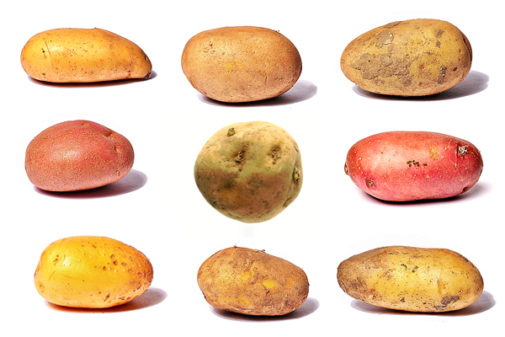For a country where the most authentic formula of the potato tortilla is discussed with passion, where every visitor who approaches the center of Madrid rushes to take a brave, our curiosity about the details of the product itself seems rather scarce. Those who frequent markets and supermarkets often find some potatoes already in bags that indicate "to fry", "to roast" and things like that. Also "Galician potatoes". Rarely, when they are in bulk, we find some mention of the variety; for example, Kennebec . (Detail: born in nurseries United States 70 years ago).
Should we be more interested in what type of potato we eat? Anyone who has traveled through France has been drawn to those deployments of dozens of varieties, each with its name, and buyers looking for the one that they know is going to go perfectly for their dish -puré, fried, roasted with his skin ...- and not content with less.
It is curious that the country that introduced the potato in Europe has barely created - by crosses in the nurseries - own varieties. In the Old Continent the primitive varieties arrived mainly from Peru are not cultivated, the "native potatoes" ( Solanum tuberosum subsp. Andigenum ), but others developed in European or North American nurseries ( Solanum tuberosum subsp. Tuberosum ). They come from Holland, Germany, France, Canada ... For example, that light brown, round and not very large potato that we see a lot here today is the Dutch Monalisa , which dates from 1982.
The French, meanwhile, first place among their preferences the small and elongated native Ratte , very fine and particularly adapted for use in salads, steamed, baked or stews.
Following the inquiries about the uses of the different subspecies we find curiosities such as that the hamburgers in the United States use the Russet Burbank to make their fries, or that the Canadian Yukon Gold has yellow meat.
As we remember from the fascinating street stalls in Lima, the variety of "native potatoes" is fascinating, and they are very different, usually with more convoluted shapes and a multiplicity of colors, than we see in Europe.
Returning here, another curiosity is that Spain has two small redoubts, insular both, of potatoes of great originality and interest, but that have barely reached us on the peninsula: Canary Islands and the island of Ibiza.
The Canary Islands, probably the first European entry point for potatoes around 1560, are the only place in Europe where those native potatoes "( subspecies andigenum ) continue to be grown and commercialized. Some author writes that certain of them did not arrive directly from America, but later, bounced from the British nurseries of Kew Gardens. Anyway, there they are, to the surprise of visitors who discover black potatoes, or delight, already cooked, with wrinkled potatoes ...
No less than 29 subspecies of old potatoes Canary Islands have Designation of Origin issued by the European Union: Negrita El Hierro, Buena Moza or Palm, White, Colorada, Corralera Tijarafera, Corraleda Colorada, Corraleda legitimizes Carralera, Negra de La Palma, black Veteada, scratched or Jorge, Haragana, Eye Blue, White, Monigo Camel, earth, Azucena black, White Lily, Pretty black, Pretty Blanca, Nice Colorada, Beautiful Scarred, Beautiful birdseye, Borralla, Colorada Baba, Black Egg Yolk, White Wig, Black Wig, Red Wig and Terrenta. Almost nothing. But European varieties also arrived, and now the native ones are relaunched.
No less than 29 subspecies of old Canarian potatoes have Designation of Origin granted by the EU
The case of Ibiza is smaller, because the Ibizan potato that has become famous is a unique subspecies of red skin and excellent culinary qualities. But its problem is the shortage (recently there were only a couple of hectares planted) and the confusion with another imported red potato, the Désirée , created in Holland in the 60s and arriving in Ibiza a decade later. In addition, it has occurred to the authorities to also grant the imported Sabors d'Eivissa quality label , which ends up encouraging this confusion.
In any case, as the surface of the recovered native is little to spread, we must hope that when they propose it to us it will be the genuine one.
Another issue is to get to enjoy the Canarian potatoes and the Ibizan red potato on the peninsula: there are very few and very specific places, although we know that Catalan horticulturists are planting that of Ibiza.
One solution is the - few - restaurants specializing in island cuisine, and in Madrid we have a couple that receive good products from there: the Ibizan Sa Brisa and the Canary Gofio by Cicero Canary .
Nor is it nonsense to bring a discreet cargo on the plane after a vacation in those places where so many peninsular tourists go. This chronicler keeps a great memory of the display of potatoes of all shapes and colors - with black in the first place - in the small market of San Cristóbal de La Laguna, in Tenerife. But surely you can find other supply points. And if you know any of them here, on the peninsula, let us know, that we are enthusiastic customers, eager to arouse more interest in Spain than for those "frying" bags, wow ...
According to the criteria of The Trust Project
Know more- The Gourmet
- Gastronomy
El Gastronómada Not only hamburgers live the Yankee: pasta with meatballs, thick pizzas and pastrami sandwiches
The gastronomicThe nutritious 'air bridge' from Barcelona to Madrid
The GastronómadaLa invasion of grapes guiris: Does it make sense to plant them in Spain?

